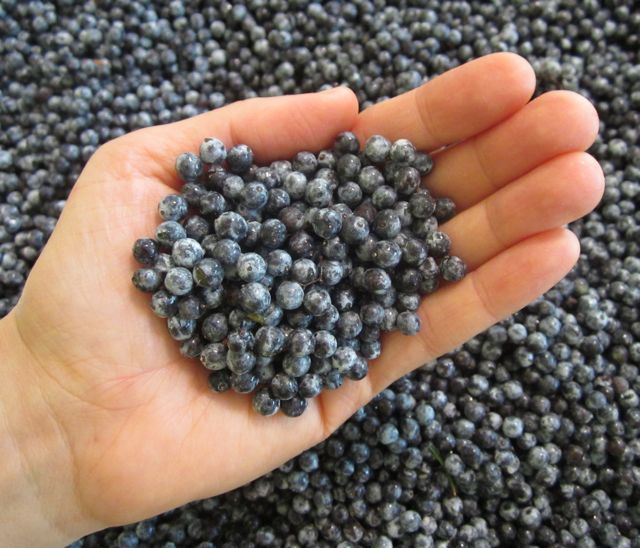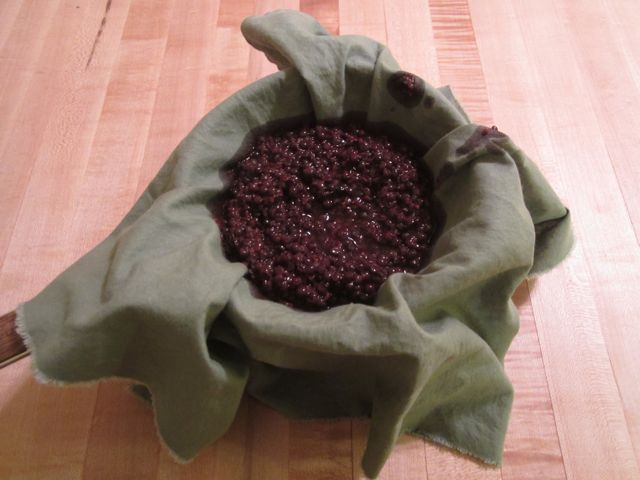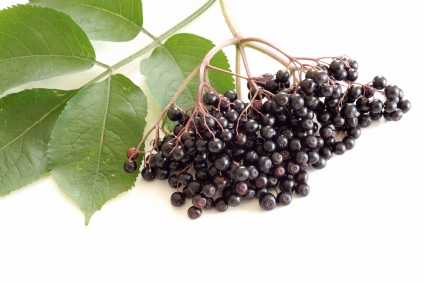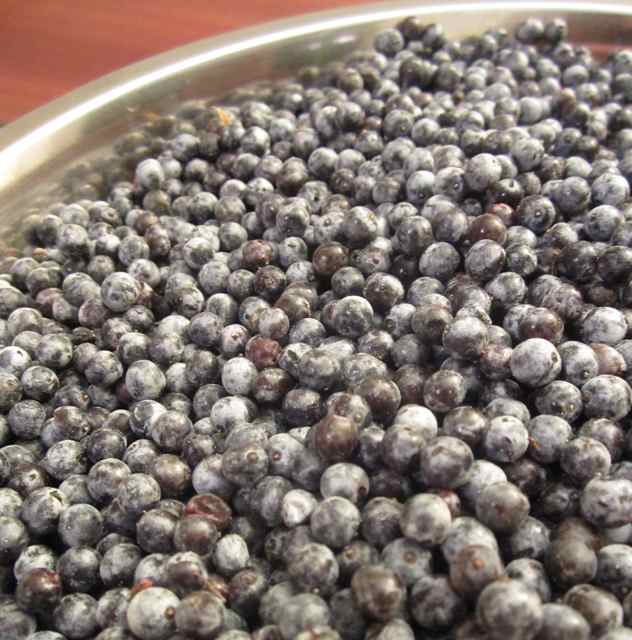
Elder is called “the medicine chest of the country people” – a pharmacy in and of itself. Today, elder flowers and berries are most prized for alleviating symptoms of colds and the flu. Historically, every part of the plant was highly valued and utilized, often commanding mythic status.
Other Names: TsiqWi’qWay (Twana) Blue elderberry Sambucus cerulea.
Identifying Blue Elder: Elder is a small tree that grows up to 20 feet high. Each leaf has five to nine opposite leaflets with serrated edges. Tiny star-shaped flowers are whitish-yellow and grow in dense flat shaped clusters. They bloom in early summer in lowlands and in late summer in the mountains. Deep blue berries develop in August through October and can get heavy enough that they cause branches to droop down toward the ground. Elder is a member of the honeysuckle family, and it grows all over the world from Alaska to Europe to Africa.
Black elder or Sambucus nigra is native to Europe and is most often referenced in herbals. It is grown as an ornamental tree in our area and can be used in the same way as blue elder along with the smaller mid-western variety called American elder or Sambucus canadensis.
Red elder or Sambucus racemosa is also common in our area. The flower and berry clusters are raceme-shaped rather than umbel-shaped, and the berries are bright red. Red elder is only eaten when it is cooked and even then it may make some people nauseous. The flowers can be used in a similar way but the whole plant has higher concentrations of hydrocyanic acids than other elders and should be used with caution.
 Where it Grows: You will find blue elder trees growing in well-drained soil in sunny locations. It is much more common on the east side of the Cascade Mountain and can be found in small pockets on the west side.
Where it Grows: You will find blue elder trees growing in well-drained soil in sunny locations. It is much more common on the east side of the Cascade Mountain and can be found in small pockets on the west side.
Harvesting and Preparation: Elder flowers are harvested in spring when most of the flowers are open and others are budding. You can cut whole flowering heads with scissors and dry them in tightly woven baskets or paper bags. Lay them in single layers. Once dry, gently massage the flowers off the stems. Discard stems and place flowers in glass jars in a cool dark place. They will last about a year.
Elder berries can be harvested in late summer to early fall. Wait until shiny blue-black berries become powdery looking. This is called the “bloom” and it occurs on other berries like blueberry. Technically “bloom” is the plant producing crystalline projections called epicuticular wax. This enhances water repellency, reflects UV radiation, and reduces dehydration during the dry season. After the bloom forms berries get sweeter and the juice becomes a deeper color.
I cut whole elderberry clusters with scissors and place them in a bag or bowl. The gathering is quick and easy if you can reach high enough. In the past I have gently worked the berries off the tiny stems but two of my friends – Abe Lloyd and Corrinne Boyer have wisely directed me otherwise. If you place the whole clusters on a cookie sheet in the freezer for an hour or so they will easily roll right of the stem with a gentle touch. If you are short on time you can freeze the clusters in plastic bags and process them later. Freezing also seems to help the berries release their juice more easily.
Fresh or dried elder flowers can be infused into alcohol, vinegar, or wine. Try a hot elder toddy when you are sick with a cold or the flu.
Fresh elder berries can be cooked, made into juice, syrup, or cordial. Partially dried berries can be infused into honey or wine. Fully dried berries are delicious as a tea. Use one teaspoon per cup of boiled water, steep for 15 minutes, and drink up to three cups a day.
Eating Elderberries: Mmmm… elderberries are sweet, complex, and earthy with blackberry and grape undertones. When I cook them, the house fills with a smell that makes people salivate. By themselves, elderberries can be a little overwhelming. Remember that they are both medicinal and nutritionally dense so a little bit will do. Also, elderberries contain rather large seeds that make some people nauseous, so try them in moderation at first to make sure you respond well.
I enjoy cooked elderberries when mixing them with other fruits. Try baking them with other berries like blackberry or blueberry. My friend Annie Brule makes apple elderberry pie with just a sprinkle of elderberries over the apples. I am anxiously awaiting a sample… Elderberries are also delicious in oatmeal. My favorite way to eat elder is as syrup. It can be drizzled over pancakes or waffles, on ice cream, or mixed with fizzy water to make a delicious beverage.
Easy Elderberry Syrup
This delicious syrup can be used on food, in drinks, or taken straight as a medicine. Sugar, glycerine, or honey can be used. White sugar depresses the immune system and is not the best choice when you are sick.
- Gather berries when they are fully ripe and have a powdery “bloom” on them. Separate berries from stems and place berries in a cooking pot.
- Pour a little water in the bottom of the pan – about 1/4 cup per quart of berries.
- Heat berries gently until the juice comes out. Mash the berries with a large flat spoon to get as much out as possible.
- Strain juice out with muslin cloth.
- Measure your volume of juice. Add an equal amount of sugar, glycerine, or honey (For every cup of juice add a cup of sweetener). Stir well.
- Pour into a glass jar with a tight fitting lid. Label and store in the refrigerator for 3 to 6 months. Mold will grow on the surface when the syrup spoils.

You can extend the shelf life of this syrup by several months by mixing a couple of tablespoons of vodka or brandy per cup of syrup.
You can add elderberry syrup to tea, soda and cocktails. This simple recipe is a great alternative to sugary soda and it pops an immune boost.
1 cup sparkling water
1 tablespoon elderberry syrup
Wedge of lemon
Mix sparkling water, syrup and squeezed lemon juice in a cup. Stir well. Add ice if desired. Garnish with frozen berries, mint spring, or a slice of lemon.
Elder Medicine: Each year as I gather, process and use elder new layers of understanding unfurl. I compare notes and swap recipes with friends, making my courtship with the plant ongoing and full of surprises. This year I am grappling with understanding the bigger picture – how the folklore, western herbal teachings, scientific studies, and nutritional qualities mirror each other and create a holisitic understanding. Here is what I am getting so far…
Ancient stories and folktales refer to elder as being connected to the divine. Elder is often seen as a gateway into the underworld. Likewise, it is sometimes referred to as a portal to the heavens. From Christianity to pagan traditions to Native American spirituality, elder has been associated with opening the way so that clear energy can flow through. This trait is seen in the anatomy of elder. Round hollow stems have a soft inner pith that can be easily removed. These have been processed into blow tubes to kindle fires and a musical instrument that plays beautiful music – often a prayer to conjure spirit. This theme of opening the way is repeated in our current understanding of elder.
Elder flowers are star-like and are known to open our lungs so one can breath in the clear air of the heavens. They also open our pores so our skin can breath. Elderberries are royal purple with blood-red undertones. They are said to connect us to our own source of vitality. In different traditions this is associated with the underworld, the earth, the blood of Christ and in Chinese Medicine – the kidneys. Elderberries are deeply nutritious and they help to revitalize that core energy when we feed depleted.
Elder flowers make a delicious floral tasting tea that has been used for centuries for breaking fevers and alleviating the symptoms of colds and the flu. They were reputed to be one of the most effective remedies for the plague and for several flu epidemics. One time I was suffering from a terrible fever accompanied with congestion. I felt on fire, agitated, and like I was going to pop. I drank a hot tea with elder flower, yarrow, and peppermint. I was able to relax and go to sleep. When I woke up several hours later I had soaked the sheets but I felt cool and calm. I was well on my way to recovery. Radiance, an herb shop in Olympia, blends these herbs and sells it as “Early Warning Tea”. When working there as an herbalist, I heard countless success stories about this tea warding off colds and the flu. It has a surprisingly pleasant taste and often makes people feel better.
Elder flowers and berries are mildly stimulating to the kidneys and have been used to relieve fluid retention and reduce swelling. They have a cooling and detoxifying action on the body, which has helped many people with arthritis and gout. Elder stimulates circulation and aids in cleansing the body by opening the pores, stimulating the kidneys and opening the lungs. It clears, cools, and decongests.
Elderberries are highly nutritious. According to Alaskan herbalist Janice Schofield, they contain vitamins A, B, and C and the minerals calcium, iron, and potassium. They also contain a fair amount of bioflavonoids, which strengthen cardiovascular tissue including arteries in the eyes and kidneys. I think of using elderberry when someone feels depleted and needs to restore their vital energy.
Elderberry syrups, tinctures, and teas are favorite remedies for children because they are so delicious and so effective. Elder flower and berry tea have a pleasant taste that most children will enjoy. You can find low-alcohol or alcohol free preparations at most herbal and health food stores.
Other Uses: The berries of elder have been used as a blue dye. The leaves are unpleasant smelling when bruised but they are an effective insect repellent for mosquitoes, flies, aphids, and caterpillars. A leaf tea can be sprayed on insect-infested plants.
Elder leaves and the inner bark have been used topically for wounds, bruises and skin problems. They are sometimes used internally to open the lungs and kidneys but, as stated above, extreme caution should be used as they can be very stimulating to the bowels and contain mildly toxic compounds. The inner bark is usually aged before use to prevent these potentially negative effects.
Elder has been called “the tree of music” because the straight stems have been used wherever it grows for making wind instruments. People have also fashioned it into blow sticks for kindling fires and pipes for smoking herbs. The stems are full of poisonous pith that can be pushed out, though it is best to boil the stem to make sure the toxic compound is removed. The result is a hollow stem that is easy to work with. Straight elder branches were also used for arrows and for twirling sticks to start fires.
Caution: Elder stems and seeds contain toxic compounds including hydrocyanic acid. Eating raw berries can cause nausea, vomiting and diarrhea in some people. The berries are fine to eat after they are cooked. When the compounds are exposed to heat they evaporate and become harmless. If you are eating large amounts of cooked berries you may want to consider removing the seeds.
Additional Resources:
The Book of Herbal Wisdom by Matthew Wood
The Forager’s Harvest and Natures Garden by Samuel Thayer
Abe Lloyd’s Blog: Wild Harvests at arcadianabe.blogspot.com/
The Foragers Harvest: Olympia area newsletter by Corinne Boyer








Hello… l wanna grow Elder trees for my mom’s kidney problems and to alleviate my cold-like asthma symptoms. l have yarrow seeds from my American pals & is finding peppermint seeds too. Will it work? Thanks 🙂
I think elderberry seeds will germinate but they do better when they have passed through the stomach of a bird! Yarrow seeds will start easily and so will peppermint. Good luck!
Hi,
Do you need to remove the tiny bits of stem that sometimes cling to the berries? I have frozen berries that I removed all the twigs and large stems from but they still have a few of the tiny stems attached.
Thanks!
Hi Alyssa. You do not need to remove all the little stems but you can remove most of them by placing the frozen berries on a towel on a cutting board or cookie sheet. Tilt the board and the berries will roll down but the stems will stay stuck to the towel.
I live in an area abundant with the red elder (Pacific Northwest) and don’t think we have the blue variety here. I was wondering if I can use the red elder for the same effect?
Red elder is not used in the same way. It does not have as strong of anti-viral properties and it has a different flavor. But I do hear Native People up at Neah Bay on the Northwest coast of Washington say that they make red elderberry jelly. It might be worth a try!
Leah, this is obviously YEARS after your comment, but I live in the PNW as well, just outside of Olympia actually. We have Blue Elderberry all over our property. I pulled into my driveway one day, and just from where I stood I could count at least 16 trees.. That was just the ones I could easily see from where I was standing,
We didn’t plant anything either, they just grow like crazy. Thanks to all of my little birdie friends. Every year we have more and more. I have yet to do anything with them. I just love them, I think they are beautiful.
We had someone come out to take a yellow jacket hive that nested in an old mole hole in the ground for the venom and he said that he had never seen so many Blue Elderberry in one spot before. Later he came back and got some cuttings from me.
We don’t have any Red Elder that I’ve seen though. Again, I’m sure you have figured this out by now, but just in case!!
Hi there, I recently made fresh elderberry syrup and I was lazy and careless and left all the stems on the elderberries when I cooked them down. Later I read that the stems contain cyanide and I freaked out a little. Should I dump my elderberry syrup? Or do you think it’s safe to consume because it has been boiled down? Thanks for the advice.
You do not need to dump your syrup. Cooking will cause the cyanic compounds to evaporate. Just try to remove the larger stems but the very tiny ones are fine.
Do you have an opinion on which berries tastes best? The blue berries, or the black berries?
I like them both and find that they are very similar.
I am now reading that red berries should be avoided but I picked some the other day that were reddish but shaped as the blue variety umbrel I am assuming these are just not as ripe? Also, I read not to use uripened berries but some were green. Do you have any thoughts and or advice on how green is too green to be edible or only if they haven’t begun to change? Thanks a bunch!!
Are you sure the berries are elder? I do not harvest and use the red elderberries, just the blue ones. There is also a red umbel shaped berry called mountain ash. Berries should be totally ripe and not green when you harvest them.
Picked some blue ones today in Northern Utah. They are ripe from about mid Sept to mid Oct. Most are not ripe yet. I’ve done this the last several years. They are in the canyons at about 5000-7000 ft elevation or so.
DO NOT eat raw. I gave myself very bad diarrhea for about 4 hrs and a very upset stomach for about 12-hrs with just a small handful ripe on a bowl of vanilla ice-cream. Cooked they are not problem, including the seeds (we have cooked them whole in muffins with no problems). We make syrup out of them and always have some in the fridge. We use the recipe above except I add water to the top of the berries and mash them with a straining device (don’t know what it’s called). Then add equal amounts of sugar to the juice that is left. It is great on vanilla ice-cream!
Thanks for sharing Bob! Cooking the berries makes the cyanic compounds evaporate off. So sorry to hear you had a strong reaction with the fresh berries.